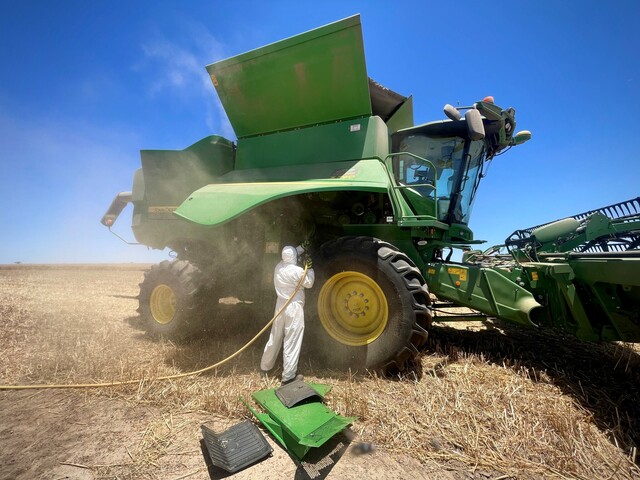The Grains Research and Development Corporation (GRDC) and fire safety experts are urging growers to adopt practical measures to reduce the risk of harvester fires during the upcoming harvest season.
Recent GRDC Harvester Set-up Workshops across Australia’s grain-growing regions have emphasised the importance of harvester hygiene and maintenance, especially for volatile crops like lentils.
Statistics reveal that about seven per cent of harvesters experience fires annually, spanning various crop types, including cereals and pulses. In these cases, one in 10 will cause significant damage to the machine or surrounding crop.
Kondinin Group research engineer Ben White presented at the workshops and said growers should maintain high levels of hygiene and pay attention to ongoing maintenance of machinery throughout harvest.
“Bearing failures are in many cases responsible for fires starting, so regular monitoring of bearing operating temperatures is important,” he said.
“Operators should be conducting regular clean downs during harvest and exercising particular caution when harvesting leafy pulse crops, as these are renowned for dust volatility.”
To enhance harvester fire safety, Mr White recommended the following: cleaning the machine regularly; starting at the front and working top-down; and finishing with a blast of air over the exhaust system.
He said to exercise extra care when harvesting pulse crops, which were more volatile than cereals.
Monitor bearing temperatures with an infrared heat gun or thermal imager to identify at-risk components could assist, and recognising the four key factors contributing to fires – relative humidity, ambient temperature, wind, and crop conditions.
Mr White recommended following state grain harvesting codes and observing fire danger protocols and having the minimum required water and fire-fighting unit available in the paddock.
Farmers could equip the harvester with extinguishers (water and A/B/E) at both the cab entry and rear, closer to the engine, for quick access.
It was important to implement a fire plan with the harvest team, clarify roles and communication channels, and keep emergency numbers in the cab.
When harvesting volatile crops, work with the wind to reduce fire spread.
In case of a fire, exit the crop immediately and face the machine into the wind before attempting to fight it.
Be aware that while static did not ignite volatile residues, it could contribute to dust accumulation on the machine.
For further guidance, the GRDC publication Reducing Harvester Fires: the Back Pocket Guide – at grdc.com.au/resources-and-publications/all-publications/publications/2023/reducing-harvest-fires – provides an easy-to-read harvester fire reduction checklist.

